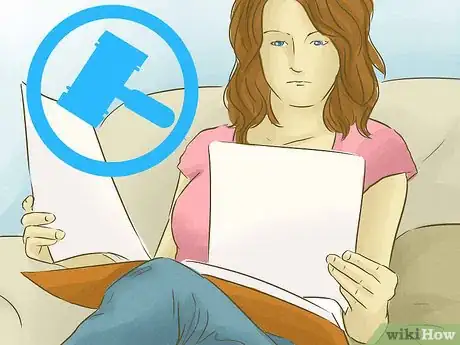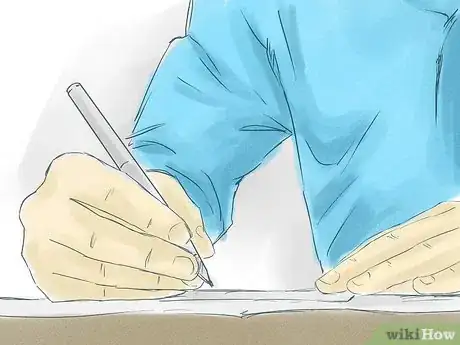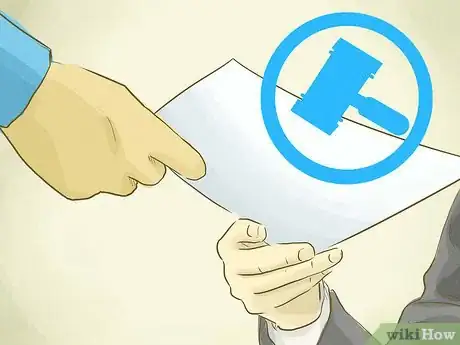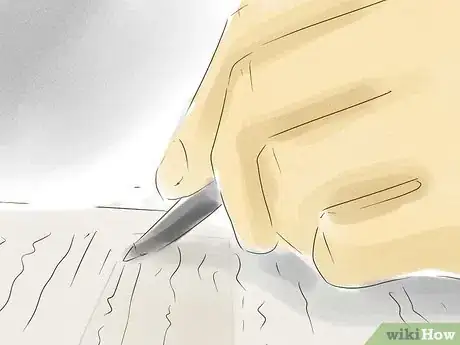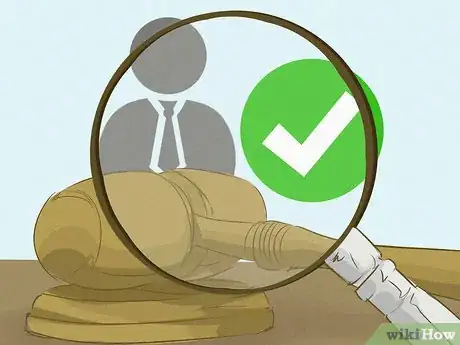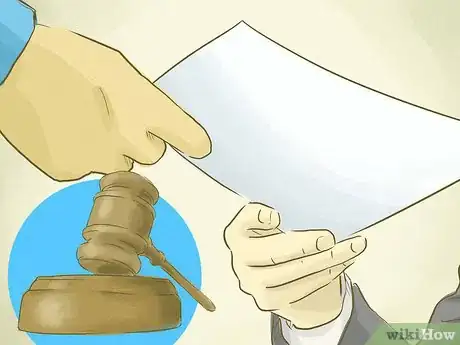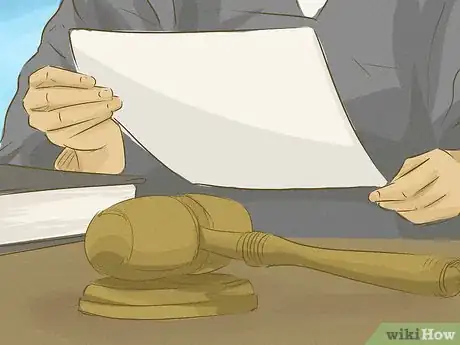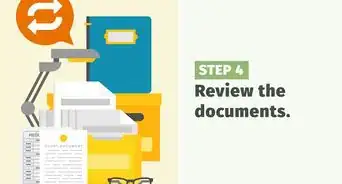This article was co-authored by Clinton M. Sandvick, JD, PhD. Clinton M. Sandvick worked as a civil litigator in California for over 7 years. He received his JD from the University of Wisconsin-Madison in 1998 and his PhD in American History from the University of Oregon in 2013.
There are 17 references cited in this article, which can be found at the bottom of the page.
This article has been viewed 115,033 times.
If you have lost a case in civil court, you can challenge the court's decision through an appeal.[1] Basically, you are asking a higher court to review the case and determine if the judge applied the law correctly. Appeals are complicated, but with work and attention to detail, it can be done without an attorney. However, someone filing a pro se (Latin for "for yourself") appeal must use the same procedures and meet the same standards as attorneys.
Steps
Deciding Whether to Appeal
-
1Understand the requirements for an appeal. In order to appeal a trial court's decision, you must be able to answer yes to all of the following questions:
- First, are you a person who can appeal the trial court's decision?[2] To answer yes, you must have been a party to the case at the trial stage.[3] You cannot appeal on behalf of someone else, for example a friend or relative.[4]
- Second, can the decision in your case be appealed?[5] To answer yes, the trial court must have issued a final judgment.[6] The final judgment is the decision at the end of your case that decides everything.[7] It will usually tell you or the other party what they have to do.[8] You cannot appeal decisions made before the final judgment; you must wait to appeal these issues once the final judgment has been issued.[9]
- Third, do you have time for an appeal?[10]
To answer yes, you must be able to draft and file your notice of appeal within a certain deadline.[11]
If you fail to file your notice of appeal before the deadline, your case will be dismissed and you will not be able to appeal.[12]
In California, the deadline to file your notice of appeal varies depending on the type of case you have. For example, if you are a part of a civil case involving an amount less than $25,000, you must file your notice by either:
- 30 days after you have been notified of the judgment; or
- 90 days after the entry of the judgment, whichever is sooner.[13]
-
2Read the judge's ruling. If you answered yes to all three questions, you have the right to appeal. However, before you appeal, you must find a valid reason to do so. Read through the judge's ruling and identify the reasons the judge ruled the way he or she did.
- Appellate courts can only look at whether the trial court made a legal error and whether that legal error changed the final decision in the case.[14]
- For example, an appeal might look at whether a trial court judge applied the wrong law to your set of facts.[15]
- Appellate courts do not offer new trials and you will not be able to present any new evidence.[16]
Advertisement - Appellate courts can only look at whether the trial court made a legal error and whether that legal error changed the final decision in the case.[14]
-
3Review your evidence. If you think you have found a legal error in the judge's ruling, look through your evidence to see whether you can back up your claim. Because you will not be able to introduce any new evidence, you need to make sure you can prove the error with the record you created at the trial level.
- For example, if you think the judge gave incorrect and harmful jury instructions to the jury, find the judge's statement of the instructions in the trial record.
-
4Consider the cost of an appeal. Between the filing fees, court fees, fees for getting materials to the appeals court, and fees for consulting an attorney, filing an appeal can be very expensive.
- An appeal also takes up a lot of time. You will be doing lots of legal research, writing a legal brief, and preparing to argue in front of the court.
- An appeal can also cause stress on you and your loved ones, and can extend the litigation for many years in some cases.
- Appellate court costs typically exceed those of the trial court. For example, in California filing a notice of appeal costs $775. It is not unusual for court transcripts to exceed $1,000. Some states have fee waivers in civil cases for individuals with low incomes (most notably California). If you received a fee waiver for your trial court case you should be eligible for one in the appeals courts.
Filing a Notice of Appeal
-
1Find a notice of appeal form. A notice of appeal is the piece of paper you file with the trial court in order to notify that court and the other party that you plan on appealing.[17] Most courts will have a form available online for you to fill out. For example, in California, the notice of appeal form can be found online and can be printed and filled out at home.[18]
-
2Draft your notice of appeal. The notice of appeal is a straightforward document and does not require any legal knowledge. In general, the notice for will ask for the following information:
- The name of the court that issued the judgment you are appealing;
- The trial court case number and case name;
- Your personal information;
- Whether this is a first appeal or some other appeal;
- The judgment you are appealing; and
- Whether you are asking for a copy of the record.[19]
-
3
-
4Serve the notice on the other party. Take one of the copies you made and serve it on the other party, either in person or through the mail.[22] If you are having your notice served in person, you must have someone other than yourself complete the task. You can ask the sheriff or a private server to do so. If you are serving the other party through the mail, send it to that party's residence, place of business, and to their attorney (if they have one).
-
5File the notice of appeal. Once the other party has been served, you will file the original notice of appeal, along with proof of service, to the court clerk.[23] The clerk will look over your documents and stamp them as "filed."[24]
- When you file your notice of appeal, you will be required to pay a filing fee.[25] The filing fee in California can be as much as $775.00. If you cannot afford the filing fee, you can ask the court for a waiver.[26] If you already obtained a fee waiver for your fees associated with your case at the trial level, simply include that fee waiver with the notice of appeal and your fees will be waived.[27]
Preparing the Record For Appeal
-
1Look at your briefing schedule. Once you decide to appeal a case and file a Notice of Appeal, you will receive a schedule for the rest of the process. This schedule will include dates for all of the hearings and dates that briefs are due.
- As the “appellant” or “petitioner,” you are the one bringing the appeal and will therefore file the first brief. The other party, the “respondent,” will file the response brief.
- To make sure that you do not miss important deadlines, you may want to place any important dates on your calendar.
-
2Read the appellate rules. Before you start preparing for your appeal, you need to read the rules that will govern your appeal. Each state has their own appellate rules that dictate how the process will unfold. The rules will explain how your appeal should look, the color of your brief cover, and how to cite to legal authorities.
- Appellate rules can cover things as small as the required font size, page limits, and the number of copies you need.
- Most appellate rules can be found online at your court's website. For example, in California, the court website has a link to the California Code of Civil Procedure and the California Rules of Court.[28]
-
3Find a practice manual. In addition to reading the rules of the court, find a practice manual to help get you through the process. A practice manual is a book geared towards helping licensed lawyers handle certain tasks.[29] Go to your local law library and find a practice guide on appellate advocacy. These types of guides can often provide you with all the information you need to successfully file and argue your appeal.[30]
-
4Designate the record. Since the appellate judges will base their decision only off of what is contained within the trial court records, you will need to gather all the documents necessary to allow the judge to rule on your appeal.[31] To designate the record, you will need to fill out a designation form.[32]
- A designation form simply asks you to identify the documents you will be including in the record.[33] Therefore, it is important to locate all the documents available from the trial court and to review them to determine if they will be helpful.
- You must designate the record within a certain period of time after filing your notice of appeal.[34] In California, you must designate the record within 10 days after filing your notice of appeal.[35] 10 days is a short period of time so be prepared to spend long hours looking through documents to determine what you want to include in the record.
-
5Prepare a record of the documents. To gather a record of the documents presented with the trial court, all you need to do is request a copy of the clerk's transcript.[36] You will request a copy of the clerk's transcript when you fill out the designation form.
- The transcript will not include any exhibits unless you ask for them (designate them).[37]
- There is usually a fee for requesting the clerk's transcript.[38] In some cases, it can cost as much as $1,000 to request and receive a copy. If you cannot afford the fee, you can ask for a fee waiver in the same manner as when you filed your notice of appeal.
-
6Prepare a record of oral proceedings. In addition to the clerk's transcript, which only includes documents that were filed with the trial court, you can also prepare a copy of what was said in the trial court proceedings.[39] To do so, you simply need to request a copy of the reporter's transcript, which is done on the designation form.[40]
- There is usually a fee for requesting the reporter's transcript.[41] If you cannot afford the fee, you can ask for a fee waiver in the same manner as when you filed your notice of appeal.
Drafting the Appeal
-
1Follow all court rules to the letter. After the appellate court files the record on appeal, which means the court has chosen the record based on what both parties requested in their designation forms, it will be time to write your brief. A brief is your written description of the facts of the case, the law that applies, and your arguments about the issues on appeal.[42] Each court has specific rules about the content, format, and length of your brief.[43] If you do not follow these rules, the clerk of courts may refuse to file it and return it to you.[44]
-
2Perform legal research. Attorneys spend years learning how to research and craft arguments. If you decide to proceed without a lawyer, you will have to find legal authority as best you can. Every argument made to an appellate court must be based on the law. The court will not consider arguments that appeal only to common sense.
- Go to your public law library. Often courthouses will have a library for public use. Some law schools may also open up their libraries to the public.
- Find the Reporters for your state. The Reporters are bound volumes of case decisions. They will be stored on a shelf. Either at the beginning or the end of the row of volumes will be an index. The index will tell you which reporters to look into depending on subject matter.
- Read up on cases involving the issue you are raising on appeal. Try and find cases that discuss the same issues you are bringing up, then try and compare or contrast your case to the cases you are finding.
- Do online research. Some states may have cases published online. Visit the website for your state’s Supreme Court. If they are publishing opinions online, there should be a link from that website to the opinions.
-
3Learn citation format. When you cite a case, you need to cite the case name and then the information of the reporter from which you got the case. You also need to include the page which states the point you are citing the case for.
- For example, a case citation might look like this: Jones v. Bethencourt, 253 S.W.2d 455 (Ky. 1997).
- In the example, the case name comes first, in italics. You can find the case name from reading the opinion; it should be the first thing stated. “253” is the volume of the reporter. “S.W.” is the name of the reporter, with “2d” designating its second edition. “455” is the page number of the legal rule you cited. In the parentheses, you list the court (here, the Kentucky Supreme Court) and the year the case was decided.
- There are many variants, depending on whether you are citing a statute, an intermediate appellate court, or a federal court. To get a better handle on these many variations, simply read the opinions. Appellate courts cite to other cases in their opinions. You should follow as best as you can their citation format.
-
4Draft your appeal. Your brief needs to conform to all of the format and style requirements found in your court's rules, and also must:
- Identify the type of case you are appealing.[45] For example, if you are appealing a tort case finding you liable for negligence, say so.
- Specify the judgment you are appealing.[46] Make sure you include the name of the trial case and that case number so the appellate court can identify the trial court ruling.
- State that the judgment is final and appealable.[47]
- Explain the standard of review. Depending on the type of case you are appealing, and what the issues are on appeal, the appellate court will use one of three standards of review.
- The abuse of discretion standard, which is used when you are appealing the judge's use of discretion.[48]
- The substantial evidence standard, which is used when you think the trial court did not have enough evidence to rule on an issue in the manner the court did.[49]
- The de novo standard, which is used when an appellate court is reviewing only questions of law.[50]
- Include a brief summary of the most important facts in your case.[51]
You must stick to facts readily available in the record that has been created. Do not add facts that are not in the record.
- You should actually support each reference to a fact with a citation to the record.[52] This will help the appellate court make sense of your argument.
- Make your legal arguments. When you do so, support each of your points with coherent arguments and a citation to some legal authority.[53]
- Indicate the relief you want.[54]
-
5File your brief. When your brief is completed, it needs to be filed with both the trial court where your first case was heard, and also the appellate court that will be hearing your appeal.[55] You must also make sure the other party receives a copy of your brief as well.
- There is usually no fee required when you file your brief.
-
6
-
7
Arguing Your Appeal
-
1Request oral arguments. Oral arguments give you an opportunity to explain your case further to the appellate judges.[60] It can also give you the opportunity to answer any questions the judges may have of you.[61] However, oral arguments are not required and you can waive them if you want.[62] To request an oral argument, return the form requesting one when you receive it from the court.[63] The oral argument request form should come after all briefs have been filed.[64]
-
2Prepare for oral arguments. If you have requested an oral argument and that request has been granted, you will need to prepare vigorously in order to competently argue in front of the court. To prepare:
- Check the laws you referred to in your brief and make sure nothing has changed.[67]
- Review the record and make sure you know it inside and out.[68] The appellate judges may ask you questions about anything in the record and you need to be prepared to answer.[69]
- Prepare your key points in outline form.[70] Do not become to rigid in your performance because you never know when a judge will interrupt you with a question.
- Practice your oral argument with someone and have them interrupt you.[71] This will help you get an idea of what it is like to speak in front of a panel of appellate judges.
-
3Argue your appeal. Start your oral argument with the phrase, "May it please the court."[72] Directly after stating that phrase, let the court know if you want to save some of your time for rebuttal. [73] Oral arguments will be limited to somewhere between 15 and 20 minutes so be sure you save time if you want to respond to what the other party says in their oral argument. You will then start your routine until you are interrupted. If this happens, stay calm and answer the questions asked as best as possible.[74] If you do not know an answer, tell them.[75]
- Remember not to discuss anything that is not in your brief or in the record.
Taking Next Steps
-
1Read the opinion. Appellate courts almost always publish an opinion after they decide a case. You or your attorney will receive a copy. In the opinion, the court should discuss why it has accepted or rejected your arguments.
-
2Consider another appeal. If you lose, you have the option of asking the full appellate court (usually 9 or more judges) to reconsider the case. You also could appeal to the next higher court—all the way up to the Supreme Court of your state or the Supreme Court of the United States, depending on your case.
- However, the highest courts (either state or federal) usually can choose to take cases and are not required to take appeals. Therefore, even if you do continue to appeal, prepare yourself for the court declining to hear your case.
- It is also highly unlikely that you can get an appeal reversed. If you have been proceeding pro se, you should meet with an attorney to discuss whether a second appeal is even worthwhile.
-
3Comply with the court’s order. If you win, the order of summary judgment will be reversed and the case will be sent back to the trial court for trial.
- If you lose, then the trial court’s judgment against you will stand.
-
4Consider settling the case. If you win your appeal, you should consider trying to negotiate a favorable settlement with the opposing party instead of proceeding to trial. The opposing party will probably be more willing to settle in a way that is favorable to you.[76]
- Additionally, even if you won your appeal, keep in mind that proceeding to trial is a risk and you could lose, regardless of whether you won the appeal or not.
Warnings
- Carefully consider if your appeal will be in good faith. If a judge finds that you are appealing a judgment without merit and that your only intention is to delay judgment, he or she can assess you with damages for the other party's expenses.⧼thumbs_response⧽
- Before you invest in the filing fee and transcript costs, consider consulting with an attorney. This is one of the most complicated parts of the practice of law.⧼thumbs_response⧽
References
- ↑ https://www.law.cornell.edu/wex/appeal
- ↑ http://www.courts.ca.gov/8546.htm
- ↑ http://www.courts.ca.gov/8546.htm
- ↑ http://www.courts.ca.gov/8546.htm
- ↑ http://www.courts.ca.gov/8546.htm
- ↑ http://www.courts.ca.gov/8546.htm
- ↑ http://www.courts.ca.gov/8546.htm
- ↑ http://www.courts.ca.gov/8546.htm
- ↑ http://www.courts.ca.gov/8546.htm
- ↑ http://www.courts.ca.gov/8546.htm
- ↑ http://www.courts.ca.gov/8546.htm
- ↑ http://www.courts.ca.gov/8546.htm
- ↑ http://www.courts.ca.gov/8546.htm
- ↑ http://www.courts.ca.gov/12429.htm
- ↑ http://www.courts.ca.gov/12429.htm
- ↑ http://www.courts.ca.gov/12429.htm
- ↑ http://www.courts.ca.gov/12428.htm
- ↑ http://www.courts.ca.gov/documents/app102.pdf
- ↑ http://www.courts.ca.gov/documents/app102.pdf
- ↑ http://www.courts.ca.gov/12428.htm
- ↑ http://www.courts.ca.gov/12428.htm
- ↑ http://www.courts.ca.gov/12428.htm
- ↑ http://www.courts.ca.gov/12428.htm
- ↑ http://www.courts.ca.gov/12428.htm
- ↑ http://www.courts.ca.gov/12428.htm
- ↑ http://www.courts.ca.gov/12428.htm
- ↑ http://www.courts.ca.gov/12428.htm
- ↑ http://www.courts.ca.gov/12428.htm
- ↑ http://www.law.northwestern.edu/library/research/illinoischicago/illinois/practiceguides/
- ↑ http://www.law.northwestern.edu/library/research/illinoischicago/illinois/practiceguides/
- ↑ http://www.courts.ca.gov/12424.htm
- ↑ http://www.courts.ca.gov/documents/app103.pdf
- ↑ http://www.courts.ca.gov/documents/app103.pdf
- ↑ http://www.courts.ca.gov/12424.htm
- ↑ http://www.courts.ca.gov/12424.htm
- ↑ http://www.courts.ca.gov/12424.htm
- ↑ http://www.courts.ca.gov/12655.htm
- ↑ http://www.courts.ca.gov/12655.htm
- ↑ http://www.courts.ca.gov/12424.htm
- ↑ http://www.courts.ca.gov/12424.htm
- ↑ http://www.courts.ca.gov/12666.htm
- ↑ http://www.courts.ca.gov/12422.htm
- ↑ https://www.courts.ca.gov/cms/rules/index.cfm?title=eight&linkid=rule8_883
- ↑ https://www.courts.ca.gov/cms/rules/index.cfm?title=eight&linkid=rule8_883
- ↑ http://www.courts.ca.gov/12422.htm
- ↑ http://www.courts.ca.gov/12422.htm
- ↑ http://www.courts.ca.gov/12422.htm
- ↑ http://www.courts.ca.gov/12431.htm
- ↑ http://www.courts.ca.gov/12431.htm
- ↑ http://www.courts.ca.gov/12431.htm
- ↑ http://www.courts.ca.gov/12422.htm
- ↑ http://www.courts.ca.gov/12422.htm
- ↑ http://www.courts.ca.gov/12422.htm
- ↑ http://www.courts.ca.gov/12422.htm
- ↑ http://www.courts.ca.gov/12422.htm
- ↑ http://www.courts.ca.gov/12422.htm
- ↑ http://www.courts.ca.gov/12422.htm
- ↑ http://www.courts.ca.gov/12422.htm
- ↑ http://www.courts.ca.gov/12422.htm
- ↑ http://www.courts.ca.gov/12421.htm
- ↑ http://www.courts.ca.gov/12421.htm
- ↑ http://www.courts.ca.gov/12421.htm
- ↑ http://www.courts.ca.gov/12421.htm
- ↑ http://www.courts.ca.gov/12421.htm
- ↑ http://www.courts.ca.gov/12421.htm
- ↑ http://www.courts.ca.gov/12421.htm
- ↑ http://www.courts.ca.gov/12421.htm#tab12638
- ↑ http://www.courts.ca.gov/12421.htm#tab12638
- ↑ http://www.courts.ca.gov/12421.htm#tab12638
- ↑ http://www.courts.ca.gov/12421.htm#tab12638
- ↑ http://www.courts.ca.gov/12421.htm#tab12638
- ↑ http://www.courts.ca.gov/12421.htm#tab12637
- ↑ http://www.courts.ca.gov/12421.htm#tab12637
- ↑ http://www.courts.ca.gov/12421.htm#tab12637
- ↑ http://www.courts.ca.gov/12421.htm#tab12637
- ↑ http://lawecommons.luc.edu/cgi/viewcontent.cgi?article=1013&context=luclj

